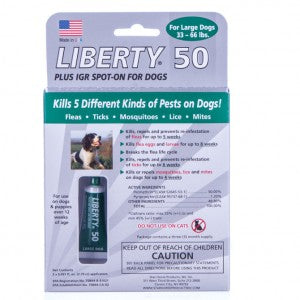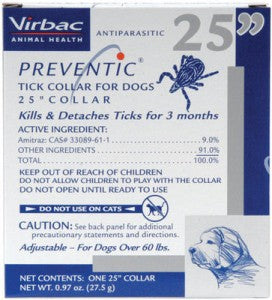Flea Wars (Part 2): Key Active Ingredients
This is Part 2 of a 2-part series on Flea Wars. Start with Flea Wars - Part 1.
Frustrating Flea Facts:
- Most of the fleas around you are living in your pet's environment, rather than in its fur. (For every flea found on your pet there could be 25-50 more living in your home.)
- The female Cat Flea, ironically the most troublesome type of flea to dogs, may produce up to 60 eggs a day and 2,000 eggs in a lifetime.
- Some pets eat 50 to 90 percent of the fleas off of their body. This is one of the leading causes of tapeworm in pets.
- The average lifespan of a flea is about 90 days.
- Adults fleas only make up about 5% of the flea population.
- Flea eggs can lay dormant for up to a year waiting for a food source before they hatch.
- Fleas adapt to their environment and become stronger and more immune to popular chemicals with each generation.
Rotation Prevents Adaptation:
One of the biggest misconceptions about flea treatment is that switching brands is the same as rotating. Rotation of active ingredients is key in getting ahead of a flea infestation. The sad truth is, the majority of the products on the market today share very few common active ingredients. If you switch from one permethrin-based brand to another, you have not accomplished anything. A rose by any other name…
Here is a brief description of each of the main active ingredients in some of the most popular flea and tick treatments available today:
The Old Standards:
LIBERTY® 50 Plus IGR Spot-On
Permethrin – A synthetic chemical used to kill fleas, ticks, lice, mosquitoes, flies and many other common pests. It has been around for a number of years and is one of the most common insecticides in the pyrethroid family. You can find it in Liberty 50 Plus IGR Spot-On. Permethrin is also an added ingredient in K9 Advantix® II (though, not the main ingredient). Permethrin is extremely toxic to cats and fish. (Related chemicals: deltamethrin, tetramethrin and cypermethrin)
Pyrethrins – Actually a pair of organic compounds found naturally in chrysanthemums. Like Permethrins (which were based on the chemical structure of the Pyrethrins), they are a neurotoxin to insects but unlike Permethrins, they are not toxic to cats. When used in smaller, non-lethal doses, pyrethrins still act as a repellent to insects. However, the pyrethrins are non-persistent and break down upon being exposed to light or oxygen. This is the active ingredient in Enforcer® Flea & Tick Spray, Bio-Groom® Flea & Tick Dip, Adams® Plus Flea & Tick Dip and Adams® Flea & Tick Shampoo.
New Kids on the Block:
Frontline® Plus for Dogs
Fipronil – The active ingredient in Frontline® TopSpot and Frontline® Plus acts on the central nervous system of insects also but with no ill effects to mammals. Besides fleas and ticks, it is also used to kill lice, cockroaches, and ants. It is extremely toxic to fish and aquatic invertebrates as well as bees and game birds.
Imidacloprid – Found in Advantage® II and K9 Advantix® II, is actually a type of neuro-active insecticide modeled after nicotine. It is noted for its low toxicity in animals other than insects (exceptions are some species of fish and earthworms) and is used primarily for fleas as well as beetles, locusts, aphids and termites. It is suspected in some mass die-offs of bee populations which threatens pollination of food crops in the US and Europe.
Nitenpyram – The active ingredient found in Capstar™ Oral Flea Treatment. It is fast-acting, but short-lived as it only kills the adult stage. It is normally used in conjunction with another type of treatment to achieve more lasting results.
IGR – Insect Growth Regulators:
Methoprene – is used in conjunction with other active ingredients. It is an IGR which breaks the flea’s life cycle by mimicking juvenile hormones which must be absent for the pupae to transform into an adult. Only adult fleas bite, making this an effective relief for your pet. Methoprene is non-toxic to humans and is used in the production of many foods. It is also commonly used to control mosquitoes in drinking water reservoirs. Some familiar products that use methoprene are Frontline® Plus, Bio-Spot® (spray, collar, and drops), and Adams™ Plus Flea & Tick Collars.
Pyriproxyfen – can be used as a treatment for cat fleas and is also a juvenile hormone analogue, preventing larvae from developing into adulthood and thus, rendering them unable to reproduce. In the U.S., pyriproxyfen is often marketed under the trade name Nylar®. Many products contain this ingredient.
Just for Ticks:
Preventic® Collar
Amitraz – An antiparasitic drug used to control mites, ticks and lice in animals. It cannot be used on horses as it causes irreversible gut stasis. Jeffers only has this available for dogs in a collar, namely Preventic®. Amitraz cannot be used on cats. Amitraz can also be found in Certifect, a new topical product from the makers of FrontLine®.
Ticked Off – A small scoop designed for removing ticks from your pet. No chemicals.
Natural Does Not Always Equal Safe
Many people assume that natural is automatically safe. Keep in mind that both peanuts and tobacco are natural (as is nicotine). However, if you have an allergy to peanuts, they can be deadly. Be aware that some less scrupulous companies have advertised as all-natural, a flea product that contained pyrethrin, which is made from the African Chrysanthemum and is thus, natural but not safe. Many natural products are known to be safe and effective, although some will argue that they are not as effective as true insecticides. Natural flea products tend to rely on essential oils. Please note that essential, in the case of oils, does not mean necessary.
An essential oil is a concentrated, hydrophobic liquid containing volatile aroma compounds from plants. They are also known as volatile or ethereal oils, or simply as the "oil of" the plant material from which they were extracted, such as oil of clove. An oil is "essential" in the sense that it carries a distinctive scent, or essence, of the plant. Essential oils do not, as a group, need to have any specific chemical properties in common, beyond conveying characteristic fragrances. – copied from Wikipedia.com
Cats have trouble metabolizing essential oils and while some people have used them with no adverse reaction, the effects are cumulative as the toxins build up over time. Many people believe that cats should never be given any essential oils, period. One common additive is d'Limonene, which is derived from citrus peels. It can be highly toxic to cats.
Tea Tree Oil (Melaleuca) – This has been known to cause a reaction in cats and is sometimes fatal.
Pennyroyal Oil – Another essential oil used in flea treatments that is sometimes dangerous to cats.
So What Can You Do:
There are some safe, natural alternatives for flea control. Note these are used as repellents and will not kill.
Brewer's Yeast with Garlic – A brewer's yeast product can be added into food as a powder or given as a treat. The brewer's yeast is very palatable to dogs. Be aware that raw garlic, onions and shallots can be toxic to pets. Read about other common household dangers to pets.
Vitamin B1 (Thiamine) – can be used as a repellent with some effect (ask your vet about dosage).
Apple Cider Vinegar – is a harmless natural repellent and strengthens the immune system. Use about a teaspoon in your pet's drinking water daily.
Non-chemical Yard Treatment:
Nematodes– What are they? Nematodes are essentially microscopic, parasitic worms that feed on insects (including flea larvae). They are not dangerous to humans, pets or even passing wildlife. They are effective as a yard treatment for fleas and ants and since they are living organisms, they multiply and so usually one or two treatments a year (after last frost) is sufficient.
Other Safe Alternatives:
Kenic Blue Bow Wow RETRO Shampoo
Grooming – Using a flea comb daily and bathing with a gentle non-chemical, shampoo is fine and eliminates most fleas. Cedar or eucalyptus shampoos might help as fleas do not like either. Do not use a detergent shampoo with topical flea treatments as they will be washed away. (Jeffers Brand Shampoos, Bio-Groom shampoos, Lambert-Kay shampoos, and Kenic brand shampoos are all safe, non-detergent formulas.)
Sanitize – Regularly wash anything your dog wears, sleeps on or plays with in hot soapy water. Be sure to rinse carefully and thoroughly. Vacuum carpets, furniture and drapes and immediately take the bag out of the vacuum, tie it up in a trash bag and dispose of it outside.
Flea Traps – One very, safe and effective method is a small electric flea trap . Most use a 4 watt (night-light type) bulb and a sticky pad. Just set in an inconspicuous, out of the way spot (in an area where your pet spends time) and the fleas will be attracted to the heat of the bulb and hop on and get stuck. It's simple, safe, clean and effective.
If you missed it, check out Flea Wars - Part 1.
This information is to be used to help make an informed decision. Nothing here is meant to suppress, supplant, or supersede the advice or diagnosis of a qualified veterinarian. JeffersPet.com has no vet on staff and makes no claims to veterinary or medical training. Always consult your vet when making changes to your pets’ diet, or any treatment. Where opinions are expressed, they are the opinion of the author and not necessarily that of JeffersPet or Jeffers, Inc.




